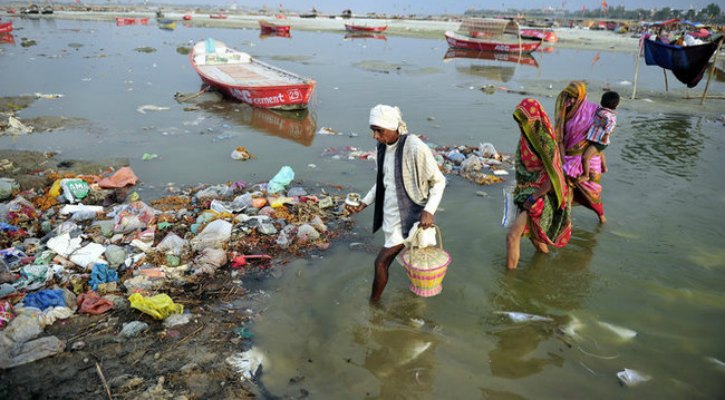In India, she is known as mother Ganges, the sacred waterway so revered that Prime Minister Narendra Modi
在印度,恒河被誉为母亲河,这条圣河受到了人们的崇敬,就连印度总理纳伦德拉·莫迪
celebrated his election win there in 2014 with a pledge to clean up the river.
都是在这里庆祝2014年大选获胜的,当时他承诺清理河道。
He has much work to do.
可谓任重道远。
The Ganges is among 10 river systems that researchers say are responsible for transporting 90% of plastic pollution into the world's oceans.
研究人员称恒河是十大“污染”河流系统之一,90%的海洋塑料污染来自这十大河流。
So it seems that larger rivers preferentially transport plastic and these are rivers with a large population.
所以看来,较大的河流系统都是塑料来源地,也是人口较多的地区。
You could reduce river plastic loads tremendously by focusing on these 10 rivers.
所以可以通过关注这十条河流来减少塑料垃圾。
Two of the rivers are in Africa, the Nile and the Niger while the remaining eight are in Asia,
其中两条河流在非洲,分别是尼罗河和尼日尔河,其余在亚洲,
the Ganges, Indus, Yellow, Yangtze, Haihe, Pearl, Mekong and Amur.
分别是恒河、印度河、黄河、长江、海河、珠江、湄公河以及阿穆尔河。
The researchers analyze studies that examine the plastic load in rivers
研究人员对河流中的塑料垃圾量进行了研究,
and compare these figures to the quantity of waste that is not disposed of properly in each river catchment.
然后将这一数据和每处集水区未妥善处理的废物数量进行比较。
The results suggest reducing waste in these rivers would go a long way to tackling ocean plastics.
研究结果表明,减少这些河流中的废物将非常有助于解决海洋塑料垃圾。
Actually it's very simple. You have to improve waste management, particularly in the developing countries,
其实非常简单,我们需要提高对垃圾的处理方法,特别是在发展中国家,
with rapid economic growth, so this is a waste management problem there.
尤其是经济发展迅猛的地区,那就会出现垃圾处理问题。

But globally, not exclusively developing countries, littering is the other source of river plastics.
但放眼全球,不光光是发展中国家,乱扔垃圾也是河流塑料污染的另一个来源。
The ecological consequences are difficult to foresee.
生态影响是很难预见的,
It is already deeply affecting marine life, so called microplastics found in cosmetics are often mistaken for food.
但已经对海洋生物构成非常大的影响,化妆品中的“微塑料”常被误认为是食物。
One recent study calculated that humans eat up to 11,000 plastic fragments in their see food every year.
根据近期一项研究计算,人类每年会食用高达1.1万个塑料碎片。
The microbeads, there might be more harmful for aquatic life, but the larger pieces over time,
微珠可能对水生生物有害,但随着时间的推移,
they are brittle and form a secondary source of microplastics.
这种微珠就会破碎,形成微塑料的次级来源。
It's estimated that just five percent of plastics are recycled effectively.
据估计,只有5%的塑料被有效地回收利用。
Total global plastic production was 322 million metric tonnes in 2015. That is expected to quadruple by 2050.
2015的全球塑料产量为3.22亿公吨,预计会在2050年前翻两番。
Henry Ridgwell for VOA News, London.
美国之音新闻,亨利·里奇韦尔伦敦报道。


